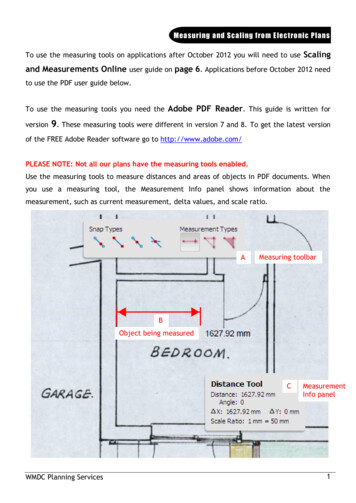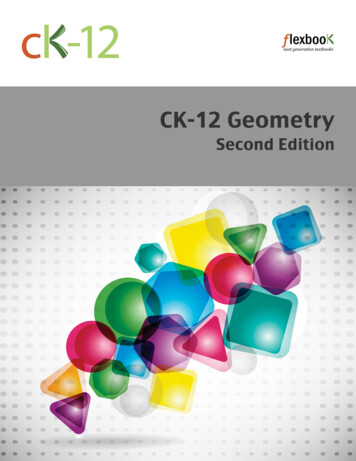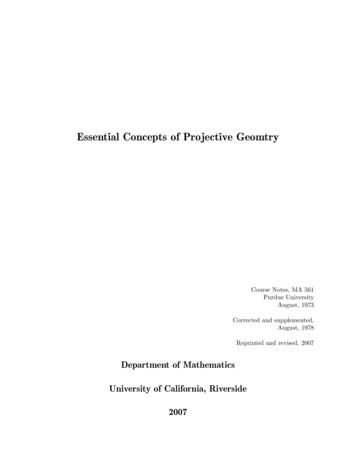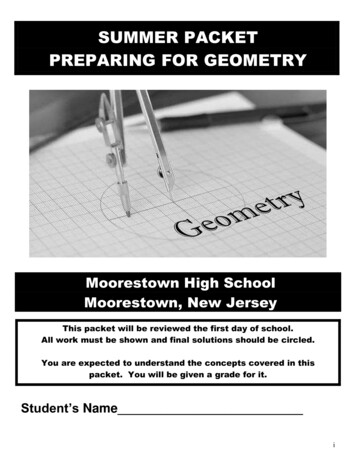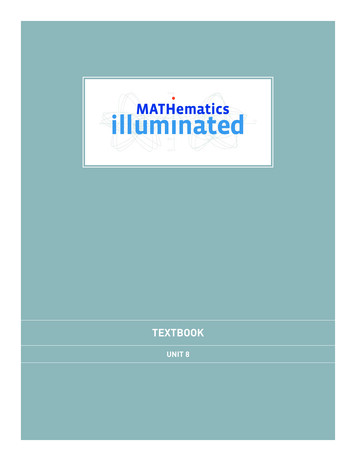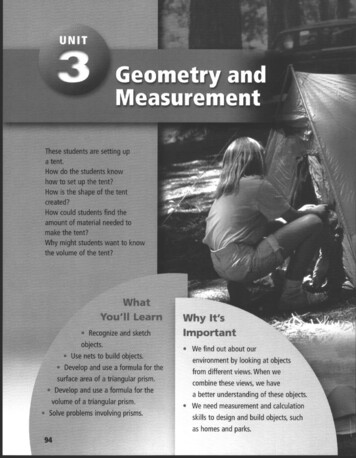
Transcription
Geometry andMeasurementimMII m1mmifwmmfiLmfssiigs vii-.-- -Hamea WhatII LearnRecognize and sketch" objtecfe.Us*, nets to build objects.Owelop and use a formula for the- surface area xif a trfangular prism.Develop afidyse a formula for thevolume of a triangular prism.Solve problems involving prisms.94Why It'sImportantWe find out about ourenvironment by looking at objectsfrom different views. When wecombine these views, we havea better understanding of these objects.We need measurement and calculationskills to design and build objects, suchas homes and parks.
#Key Wordsisometric diagrampictorial diagramtriangular prismsurface areavolume95
Drawing Isometric and Pictorial DiagramsAn isometric diagram shows three dimensions of an object. It is drawn on isometric(triangular) dot paper. Vertical edges of an object are drawn as vertical line segments.Parallel edges of an object are drawn as parallel line segments.Example 1Make an isometric diagramof this object.SolutioniOn isometric paper, join a pairof dots for each vertical edge.[ ' .Join a pair of dots diagonally foreach horizontal edge that goesup to the right.Join a pair of dots diagonally foreach horizontal edge that goes up to the left.Shade the faces so the object appears three-dimensional.In a pictorial diagram, the depth of an object is drawn to a smaller scale than thelength and width. This gives the object a three-dimensional appearance.Example 2Make a pictorial diagram of this cylinder.96UNIT 3: Geometry and Measurement
SolutionThe top and bottom of a cylinder are circles.In a pictorial diagram, a circular face is an oval.One-half of the bottom circular face isdrawn as a broken curve. This indicates thatthis half cannot be seen.Draw vertical line segments to join thetop and bottom ovals.VCheck1. Make an isometric diagram of each object.a) a rectangular prism with dimensions3 units by 4 units by 5 unitsb) a square pyramidRemember to look up any termsthat you are unsure of in the Glossary."I2. Make a pictorial diagram of each object.a) a rectangular prism with dimensions 3 units by 4 units by 5 unitsb) a regular tetrahedronCalculating the Surface Area and Volumeof a Rectangular PrismThe surface area of a rectangular prism is the sum of the areas of all its faces.Since opposite faces are congruent,this formula can be used to find the surface area:Surface area 2 X area of base 2 X area of side face 2 X area of front faceUsing symbols, we write: SA 2lw 2hw 2lhSince the congruent faces occur in pairs, this formula can be written as:SA 2(lw hw Ih)In this formula,/ represents length,w represents width,and h represents height./// The volume of a rectangular prism is the space occupied by the prism.One formula for the volume is: Volume area of base X heightUsing symbols, we write: V IwhSkills You'll Need97
Example 3A rectangular prism has dimensions 4 m by 6 m by 3 m.a) Calculate the surface area.b) Calculate the volume.SolutionDraw and label a pictorial diagram.3ma) Use the formula for the surface areaof a rectangular prism:4rrSA 2(lw hw Ih)Substitute: I 6, w 4, and h 3emSA 2(6X4 3X4 6X3) In the brackets, multiply then add. 2(24 12 18) 2(54)Area anj surface area are 108measured in square units (m2;The surface area is 108 m2.b) Use the formula for the volume of a rectangular prism:V IwhSubstitute: / 6, w 4, and h 3Volume is measured inV 6 X 4 X 3cubic units (m3)- 72The volume is 72 m3.A cube is a regular polyhedron with 6 square faces.Since all the faces of a cube are congruent,we can simplify the formulas for surface areaand volume. Each edge length is s.The area of each square face is: s X 5 s2So, the surface area of a cube is: SA 6s2The volume of a cube is: V s X s X s s3Check3. Find the surface area and volume of each rectangular prism.Include a labelled pictorial diagram for each rectangular prism.a) 12 cm by 6 cm by 8 cmb) 7 mm by 7 mm by 4 mmc) 2.50 m by 3.25 m by 3.25 md) 5 cm by 5 cm by 5 cm98UNIT 3: Geometry and Measurement
Calculating the Area of a TriangleThe area of a triangle is calculated with either of these formulas:Area base X height -s- 2, or These formulas are equivalent.Area one-half X base X heightDividing bh by 2 is the same asUsing symbols,multiplying bh by \.we write: A -f or A frhwhere b is the length of the base and h is the corresponding height.V\Example 4The side lengths of APQR are 12 cm, 5 cm, and 13 cm.p12 cm5 cm-i13 cma) The height from P to QR is about 4.6 cm.Use this to calculate the area of APQR.b) Triangle PQR is a right triangle with ZP 90 .Use this to calculate the area of APQR a different way.Solutionbha) Use the formula: A -yheightSubstitute: b 13 and h 4.6.13 X 4.6A 25M 2 29.9The area is 30 cm2 to the nearest square centimetre.Skills You'll Need99
b) Since APQR is a right triangle,the two sides that form the right angleare the base and height.ZQPR 90 , so QP 5 cm is the height;12 cm5 cmand PR 12 cm is the base.Use the formula: A ySubstitute: b 12 and h 513 cm.12 X 560-Any triangle has 3 sets of base and height.All sets produce the same area.2 30The area is 30 cm2.CheckHUBH4. Calculate the area of each triangle,a)y\b)OOcm6 cm4.8 cm10 m8 cmConverting among Units of Measure'%-,%,. ,-100 cm -1 m 100 cm1 mjy ' ? j:- : "i s-i--' '' " '" The area of a square with side length 1 m is:A 1 m X 1 m 1 m21 mThe area of a square with side length 100 cm is:A 100 cm X 100 cm100 cm - -1m 10 000 cm2So, 1 m2 10 000 cm2, or 104 cm2100 cm100UNIT 3: Geometry and Measurement
The volume of a cube with edge length 1 m is:V 1m X 1m X 1 m lm31 mThe volume of a cube with edge length 100 cm is:100 errV 100 cm X 100 cm X 100 cm1 m 1 000 000 cm3100 cmSo, 1 m3 1 000 000 cm3, or 106 cm3100 cmThe volume of a cube with edge length 10 cm is:V 10 cm X 10 cm X 10 cm 1000 cm3Since 1 cm3 1 mL,then 1000 cm3 1000 mL 1LExample 5Convert.b) 1.05 m3 to cubic centimetresa) 0.72 m2 to square centimetresSolutiona) 0.72 m2 to square centimetres1 m2 10 000 cm2So, 0.72 m2 0.72 X 10 000 cm2 7200 cm2To multiply by 10 000, move thedecimal point 4 places to the right.b) 1.05 m3 to cubic centimetres1 m3 1 000 000 cm3, or 106 cm3So, 1.05 m3 1.05 X 106 cm3 -* 1 050 000 cm3- -This answer is in scientific notation.This answer is in standard form./ Check5. Convert. Write your answers in standard form and in scientific notation,where appropriate.a) 726.5 cm to metresb) 4300 cm2 to square metresc) 980 000 cm3 to cubic metresd) 4 280 000 cm3 to litrese) 8.75 m to centimetresf) 1.36 m2 to square centimetresg) 14.98 m3 to cubic centimetresh) 9.87 L to cubic centimetresSkills You'll Need101
m? FocusRecognize, build, and sketch an objeigiven different views of the object.When we draw a view of an object, we show internal line segmentsonly where the depth or thickness of the object changes.Here is an object made with 7 linking cubes.Here are the views:SideFrontRight SideThe broken lines show howthe views are aligned.xplore ; ' \ V:.V\./y ;:::,: . . X .Work in a group of 3.Each student needs 8 linkingcubes and isometric dot paper.TopEach student chooses oneof these views.Left SideFrontYou use 8 cubes to build an object that matches the view you chose.Sketch your object on isometric paper.Use your cubes to build, then sketch, a different object with the viewyou chose.Reflect & ShareCompare your objects with those of other members of your group.Does any object match all 3 views?If not, build and sketch one that does.What helped you decide the shape of the object?Are any other views needed to identify the object? Explain.102UNIT 3: Geometry and Measurement
S H ft BB BSHiEach view of an object provides information about the shape of theobject. When an object is built with linking cubes, the top, front, andside views are often enough to identify and build the object. Theseviews are drawn with the top view above the front view, and the sideviews beside the front view, as they were at the top of page 102.In this way, matching edges are adjacent.ExampleWhich object has these views?TopSideSolutionFrontThe top view is a regular hexagon.The side view is 2 congruent rectangles.The front view is 3 rectangles, 2 of which are congruent.This object is a hexagonal prism.3.1 Building and Sketching Objects103
Practice.: ,. --.--. ."I- '1 '.i A1-!1 " .'-mYou will need linking cubes, isometric dot paper, and grid paper.1. Match each view A to D with each object H to L.Name each view: top, bottom, front, back, left side, or right side-: ::/ * S:::-.':-" -.::::":' . ':: : 7: . . -. -- .h ;i.A.k1Jo2. Sketch a different view of two of the objects in question 1.3. Use these 4 clues and linking cubes to build an object.Draw the object on isometric paper.Clue 1: There are 6 cubes in all. One cube is yellow.Clue 2: The green cube shares one face witheach of the other 5 cubes.Clue 3: The 2 red cubes do not touch each other.Clue 4: The 2 blue cubes do not touch each other.4. a) Build the object for the set of views below.b) Sketch the object on isometric dot paper. ronf RkjhtSidej104UNIT 3: Geometry and Measurement -
The relationship in part c5. a) Build an object with each number of linking cubes.For 3 or more cubes, do not make a rectangular prism.i) 2is called Euler's formula. Itii) 3iii) 4iv) 5v) 6b) For each object you build, count the number of its faces,edges, and vertices. Record your results in a table.c) Look for a pattern in the table in part b.For any object, how are the numbers of faces, edges,is named for a Swissmathematician, LeonhardEuler, who lived in the18th century.and vertices related?d) Build an object with 7 linking cubes.Check that the relationship in part c is true.6. Assessment FocusNumber Strategiesa) Use these views to build an object.Wiilee.ich numtn inTop Viewscientific notation. 3 590 000I40 400 000I398 759r JRight Side Viewb) Sketch the object on isometric dot paper.c) Draw the other views of the object.7.a) Use these viewsto build an object.A shaded region hasTop Viewno cubes.b) Sketch the object.Explain your work.wiFront View Right Sjde View ReflectHow do views help to show a three-dimensional object?Use an example to explain.3.1 Building and Sketching Objects105
JC*'FocusSketch nets and use them to build objects.A net is a pattern that canbe folded to make an object.G 33Here is a net and therectangular prism it forms.A polyhedron can have several different nets.ExploreWork with a partner.You will need scissors, tape, and 1-cm grid paper.For each set of views below: Identify the object. Draw a net of the object. - Cut out your net. Check that it folds to form the object. - Describe the object.Set ATop View6 cm5 cmFront ViewRight Side View6.5 cm2.5 cm6 cm5 cmTop ViewRemember that anSetBinternal line segmenton a view shows that6 cmthe depth changes.Left Side ViewFront ViewRight Side View6 cm6 cm106UNIT 3: Geometry and Measurement6 cm6 cm
Reflect & ShareCompare your nets with those of another pair of classmates.How did you know how many faces to draw?How do you know which faces share a common edge?How do the faces on the net compare to the views for each object?Could you have drawn a different net for the same object? Explain.ConnectSome faces are not visible from a particular view.Look at the views of an object, at the right.5 cmThe top view shows that four congruenttriangular faces meet at a point.5 cmThe front and side view shows an6 cm /isosceles triangular face.The bottom view shows the base is a square.This object is a square pyramid.We can use a ruler, protractor, and compass to\ 6 cm/Front/SideN5 cmdraw the net.In the centre of the paper,draw a 5-cm squarefor the base.On each side of the base,draw an isoscelestriangle with twoequal sides of 6 cm.Other arrangements of the five faces mayproduce a net.Each outer edge must match anotherouter edge, and no faces must overlap.The net at the right is constructed so thatthe 5-cm square base is attachedto only one triangle.6 cm3.2 Sketching and Folding Nets5 cm107
Each net folds to form a square pyramid.\Many views of an object are needed tocreate its net, especially if the objectis made with linking cubes.ExampleThese four views showTop Viewan object madewith linking cubes.Use the views to drawFront/Back View i Left/Right Side Viewa net for the object.Bottom ViewSolutionUse 1-cm dot paper.Start with the simplest view, which is the bottom view.Draw the bottom face.Draw the front face and back face aboveand below the bottom face.The top view and side views show a change in depth.A new face is drawn for each depth change.A side square is drawn for each depth change.TopFrontSideTop SideBottomBack108UNIT 3: Geometry and MeasurementSide TopSideEach side view is drawn totouch the square that showsthe change in depth.
The net in the Example folds to formthis object with 10 faces, includingthe bottom face.The symmetry of the object made iteasier to draw a net. Otherarrangements of the 10 faces maybe folded to form the object.Each set of views below represents an object.a) Identify each object.b) Draw a net for the object.c) Cut out the net. Build the object.d) Describe the object.jj)i)Top ViewTop View2 cm8 cmFront ViewSide ViewSide View8 cm3 cm3 cm6 cm2 cm1.7 cm2 cm2. Each set of views represents an object.Draw 2 different nets for each object.Build the object.a) Tod View Top View,3;4 cm7 cmFront/Side View3. Choose one set of views from question 2.Describe the steps you used to draw the net.3.2 Sketching and Folding Nets109
4. A chocolate box has the shape of a prism with a base that is arhombus. Each side length of the rhombus is 3.6 cm.The angles between adjacent sides of the base are 60 and 120 The prism is 10.8 cm long.Officials mark thea) Draw a net for this box.perimeter of a playingfield with spray paint.One can of paint covers50 m of perimeter.How much paint isneeded to spray theperimeter of each field?b) How is your net different from the cardboard net fromwhich the box is made? Explain.5.These views represent an object.Each shaded region is an opening in a face.Draw a net for the object.Build the object.Lacrosse field:Top View100 m by 55 m» Soccer field:109 m by 73 m ca MUmiEilOirn6 cm8 cm6. Assessment FocusThese views represent an object.a) Identify the object.Top Viewb) Draw two different nets.5 cmc) Use the two different8 cmnets to build the object.5 cmRightcFront Viewd) Is one net easier todraw or fold? Explain.5 cmSide Viewcm5 cm9 m4 cm18 cm5 cmReflectDescribe how a set of views of an object relates to the figureson a net of the object. Is there one correct net for a set of views?Explain with an example.110UNIT 3: Geometry and Measurement
BMid-Unit Review».11.3. Each set of views that followsa) Use linking cubes.Use the views below to buildrepresents an object.a) Identify each object.b) Draw a net for each object.the object.Remember that internal linesc) Cut out the net.show where the depth of theobject changes.Build the object.d) Describe the object,i)Top ViewTop View 3 cmÿJn7 cmLeftSMe Front View Right SideView *ViewFront ViewRight Side Viewb) Sketch the object on isometricdot paper.2. a) Use the views below to describe2 cmthe object. Remember that ashaded area shows an openingin the face.Top View1 cm2 cmRight Side ViewFront Viewiii)Top View12 cmFront/Side Viewb) Sketch a pictorial diagram ofthe object.8 cm12 cmMid-Unit Review111
FocusDevelop a formula for finding the:area of a triangular prism.A triangular prism is formedwhen a triangle is translated in the airso that each side of the triangleis always parallel to itsoriginal position.The two triangular faces arethe bases of the prism.Explorea-.: v;.Work with a partner.You will need 1-cm grid paper. For each triangular prism below:Draw a net.Find the surface area of the prism.The surface area of anobject is the sum of theareas of its faces.2.5 cm6 cm6 cm4 cmPrism APrism B Write a formula you can use to find the surface area of anytriangular prism.Reflect & ShareCompare your nets and formula with those ofanother pair of classmates.Did you write the same formula?If not, do both formulas work? Explain.Did you write a word formula or use variables? Explain.112UNIT 3: Geometry and Measurement,
Here is a triangular prism and its net.Both the prism and net are drawn to scale.Area 16.5 cm28 cm8 cm5 cm5 cm2 cmdArea 22 cm2Area 16 cm22 cm11 cmArea 10crrrArea 16.5 cm2The area of a rectangleis base x height.Use the order ofThe two triangular faces of the prism are congruent.Each triangular face has base 11 cm and height 3 cm.So, the area of one triangular face is: j X 11 X 3The surface area of a triangular prism can be expressedusing a word formula:SA sum of the areas of three rectangular faces 2 X area of one triangular faceUse this formula to find the surface area of the prism above.SA (5 X 2) (11 X 2) (8 X 2) 2 X \ X 11 X 3operations. Multiply 10 22 16 33before adding. 81The surface area of the prism is 81 cm2.We can use variables to write a formula for the surface area of atriangular prism.A atA biA cfTo avoid confusion between the height of a triangle and the height ofthe prism, we now use length instead of height to describe the edgea, b, c, h, and / arevariables.that is perpendicular to the base.For the triangular prism above:The length of the prism is /.Each triangular face has side lengths a, b, and c.The height of a triangular face is h and its base is b.3.3 Surface Area of a Triangular Prism113
When you use thisformula, you mustidentify what eachvariable represents.ExampleThe surface area of the prism is:SA sum of the areas of the 3 rectangular faces 2 X area of onetriangular faceSA al bl cl 2X \bhSA al bl d bhFind the surface area of the prism below.Each dimension has been rounded to the nearest whole number.Write the surface area in square centimetres and in square metres.20 cm31 cmSolutionIdentify the variable that represents each dimension.Sketch, then label the prism with these variables.The length of the prism is:1 40The 3 sides of a triangular face are:a 20, b 31, c 29The height of a triangular face is:a 2a 40h 18Substitute for each variable in the formula for surface area.SA al bl cl bh (20 X 40) (31 X 40) (29 X 40) (31 X 18) 800 1240 1160 558 3758There are 10 000 cm2The surface area of the prism is 3758 cm2.To convert square centimetres to square metres, divide by 10 000.in 1 m2.37583758 cm2 10 000 m 0.3758 m2The surface area of the prism is 0.3758 m2.114UNIT 3: Geometry and Measurement
Practice.v 3 X &&&Mzx &: :: ,J;. A1. Calculate the area of each net.a)b)4.5 cm2 cm3m4 cm4 cmNumber Strategies5 mUse up to four 3s. Use any of , - , x , or -h . Write an expression forfeach number from 1 to 5. I2. Calculate the surface area of each prism.Draw a net first if it helps.Write the surface area in square metres.a)b)10 cm-9m50 cm5 m11 m3. Calculate the surface area of each prism.The shaded region indicates that the face is missing.Write the surface area in square centimetres.a).b)6 cmWhen a face of a prismis missing, the prism isa shell, not a solid.13 cm7.00 m200 cm776 cm750 cm250 cm12 cm4. a) What area of wood, in square metres, is needed to make theramp at the left?The ramp does not have a base.b) Suppose the ramp is built against a stage.The vertical face that is a rectangle is against the stage.How much wood is needed now?3.3 Surface Area of a Triangular Prism115
-23 cm-\ e5 cm5. A plastic container company designs a container with a lid tohold one piece of pie.a) Design the container as a triangular prism.Explain your choice of dimensions.b) Calculate the area of plastic in your design.6. The total area of the 3 rectangular faces of an equilateraltriangular prism is 72 cm2.a) No dimension can be 1 cm. What are the possiblewhole-number dimensions of the edges?b) Sketch the prism with the greatest length.Include dimensions. Explain your choice.7. Assessment FocusHow much metal, in square metres,is needed to build60 cm120 cmthis water trough?50 cm40 cm8. A right triangular prism has a base with perimeter 12 cm andarea 6 cm2.a) Find the whole-number dimensions of the base.b) The length of the prism is 6 cm.Calculate the surface area of the prism.c) Sketch the prism. Include its dimensions.Take It Further9. Use the variables below to sketch and label a triangular prism.The lengths have been rounded to the nearest whole number.Calculate the surface area of the prism.a 7 cm, b 17 cm, c 11 cm, h 3 cm, I 12 cmReflectWrite to explain how to find the surface area of a triangularprism. Include an example and a diagram.116UNIT 3: Geometry and Measurement
usFocusRecall that the area of a triangle is one-half thearea of a rectangle that has the same base and height.That is,the area of ADEC \ the area of rectangle ABCDWork in a group of 4.You will need 4 identical cereal boxes, one for each group member,and markers. - Find the volume of your cereal box, which is a rectangular prism. - Use a ruler to draw a triangle on one end of the cereal box.The base of each triangle should be along one edge of the box.The third vertex of the triangle should be on the opposite edge.Make sure you draw different triangles.What is the volume of a triangular prism with this triangle as itsbase, and with length equal to the length of the cereal box? Compare your answer with those of other members of yourgroup. What do you notice? Work together to write a formula for the volume of atriangular prism.Reflect & ShareHow is the volume of a triangular prism related to the volume of arectangular prism?Compare your formula for the volume of a triangular prism withthat of another group.Did you use variables in your formula?If not, work together to write a formula that uses variables.ConnectThe volume of a rectangular prism is:V base area X lengthbase area - -3.4 Volume of a Triangular Prism117
Suppose we draw a triangle on the base of the prism so that the baseof the triangle is one edge, and the third vertex of the triangle is onthe opposite edge.The volume of a triangular prism with this base, and with lengthequal to the length of the rectangular prism, is one-half the volumeof the rectangular prism.base areaSince the base area of the triangular prism is one-half the base areaof the rectangular prism, the volume of a triangular prismis also: V base area X lengthThe base is a triangle, so the base area is the area of a triangle.We can use variables to write a formula for the volume ofa triangular prism.For the triangular prism below:The length of the prism is I.Each triangular face has base b and height h.The volume of the prism is:When we use thisV base area X lengthformula, we mustV \bh XIidentify what eachvariable represents.V kbhlExampleHow much water can the water trough hold?Give the answer in litres.60 cm120 cm50 cm40 cm118UNIT 3: Geometry and Measurement
b 60(, 120SolutionCapacity is theThe amount of water the troughcan hold is the capacity ofthe triangular prism.amount a containerh 40will hold, commonlymeasured in litres (L)or millilitres (mL).Volume is the amountSketch the prism.of space an objectoccupies, commonlyIdentify the variable that represents each dimension.The base of the triangle is: i 60The height of the triangle is: h 40The length of the prism is: Z 120measured incubic units.Substitute for each variable into the formula for volume.V \bh\V \ X 60 X 40 X 120V 144 000The volume of the trough is 144 000 cm3.1000 cm3 1 LSo, 144 000 cm3 144 LThe trough can hold 144 L of water.Practice-' .- : *« ir«& V:. . . ,-; I; r sfes X:;, tm1. The base area and length for each triangular prism are given.Find the volume of each prism.a) rNb)5 cm ,C)15 mA 9.2 cm223 cmA 43.5cm2A 3m!2. Find the volume of each triangular prism.1.75 m8m21 cm1.75 m13 cm3.4 Volume of a Triangular Prism119
3. Calculate the volume of each prism.a)4.4 cmb)11.2 cm x 6.8 cm3 cm6.7 cm15.6 cm6 cm15.5 cm12 cmUse an isometricdiagram or a pictorialdiagram for the sketchof the prism.4. Find possible values for b, h, and I for each volume of atriangular prism. Sketch one possible prism for each volume,a) 5 cm3b) 9 m3c) 8 m3d) 18 cm35. What is the volume of glass in this prism?6. Any face can be used as the base of a rectangular prism.Can any face be used as the base of a triangular prism? Explain.7. The volume of a triangular prism is 30 cm3.Each triangular face has an area of 4 cm2.How long is the prism?8. a) Calculate the surface area and volume of this3m5m4m2mtriangular prism.b) What do you think happens to the surface area and volumewhen the length of the prism is doubled? Justify your answer.Calculate the surface area and volume to check your ideas.c) What do you think happens to the surface area and volumewhen the base and height of the triangular faces are doubled?Justify your answer.Calculate the surface area and volume to check your ideas.d) What do you think happens to surface area and volume whenall the dimensions are doubled?Justify your answer.Calculate the surface area and volume to check your ideas.120UNIT 3: Geometry and Measurement
3m9. Assessment Focus Jackie uses thisform to build a concrete pad.a) How much concrete will Jackie3m-M 0.25 mneed to mix to fill the form?The form is notb) Suppose Jackie increases the equal(»drawn to scale.sides of the form from 3 m to 6 m.How much more concrete will Jackie need to mix?Include a diagram.Number Strategies10. A chocolate company produces different sizesof chocolate bars that are packaged inequilateral triangular prisms.Here is the 100-g chocolate bar.The number 12 has six3.1 cmfactors: 1,2, 3,4,6, and 12.Which number less than 50has the most factors?3.5 cmList the factors of thisa) Calculate the surface area and volume of the box.number.b) The company produces a 400-g chocolate bar.It has the same shape as the 100-g bar.i) What are the possible dimensions for the 400-g box?ii) How are the dimensions of the two boxes related?Take It Further11.The volume and surface area of a prism, with a base that is nota triangle or a rectangle, can be found by dividing the prisminto smaller prisms.Find the volume and surface area of each prism.a) »4 m V5 mb). 2.1 cm 6 m1.8 cm5 cm1 cm1.5 cm5 cm-ReflectDescribe the relationships among the dimensions, faces,and volume of a triangular prism.Include an example in your description.3.4 Volume of a Triangular Prism121
Features of Word ProblemsIn Unit 2, you wrote problem statements as questions.Math problems include information to help you understandand solve the problem.Here are some features of math word problems.Context - may describe who, what, when,where, and why, like the setting of a story.Suppose you have an old refrigerator andare thinking about buying a new one.Math Information - may include words,numbers, figures, drawings, tables, graphs,Mathand/or models.InformationProblem Statement - tells you to dosomething with the information. It may bea question or an instruction. Key words areProblemsometimes used to suggest how theStatementresponse is to be communicated.The new refrigerator costs 900.It costs 126 a year to run yourold fridge, and 66 a year to runthe new, more energy-efficient fridge.Is it more economical to buy the newfridge? Justify your answer.To solve the problem, we need to compare the costs of buying thenew fridge and running it with the costs of running the old fridge.We can use a table and a graph.In the second column of the table, add 126 each year.In the third column of the table, add 66 each year.Cumulative CostsYearOld Fridge Cost ( )New Fridge Cost ( )1126900 66 9662252103233781098Cumulative Costs of Fridges1400New fridge1200g 1000? 800O450411645630123067561296788213624002000Here is part of the table and a graph.Continue the table until the costs are equal.Draw a graph for the data.Use the table and graph to solve the problem.122UNIT 3: Geometry and Measurement *600jS* -Old fridge12 3 4 5Year6 7
. ' "VCheckCARPETSALERegular 9.99With a partner, identify the context,math information, and problemstatement for each of questions 1 to 4.Then solve the problem.1. Hori is buying carpet forhis living room.It is rectangular with dimensions4 m by 5 m.How much will Hori save if he buys the carpet at the sale priceper square metreshown at the left?Now on Sale2.20%Suppose you are in charge of setting up the cafeteria for agraduation dinner. One hundred twenty-two people will attend.The tables seat either 8 or 10 people.You do not want empty seats.offHow many of each size table will you need to use to make sureeveryone has a seat? List all the combinations.3.To win a contest, you have to find a mystery number.The mystery number is described this way:Sixteen more than y of the mystery numberis equal to two times the mystery number.What is the mystery number?4.Alicia and Chantelle are playing a game.There are six tiles in a box: three red and three blue.A player picks two tiles without looking.Alicia gets a point if the tiles do not match; Chantelle gets a pointif they do match. The tiles are returned to the box each time.What is the probability that both tiles have the same colour?Is this a fair game? Explain.Write a word problem using the numbers 48, 149, and 600.Remember to include a context, math information,and a problem statement.Trade problems with a classmate.Identify the features of your classmate's problem.Solve the problem.Reading and Writing in Math: Features of Word Problems123
Review any lesson withoniine tutorial , Euler's FormulaFor any polyhedron, the numbers of faces, edges, and vertices arerelated by this formula:vertices faces edges 2 Surface Area of a Triangular PrismSurface area sum of the areas of 3 rectangular faces 2 X area of one triangular faceSA al bl cl bhHi!The side lengths of a triangular face are a, b, and c.The height of a
5. Convert. Write your answers in standard form and in scientific notation, where appropriate. a) 726.5 cm to metres b) 4300 cm2 to square metres c) 980 000 cm3 to cubic metres d) 4 280 000 cm3 to litres e) 8.75 m to centimetres f) 1.36 m2 to square centimetres g) 14.98 m3 to cubic centimetres h) 9.87 L to cubic centimetres Skills You'll Need 101

